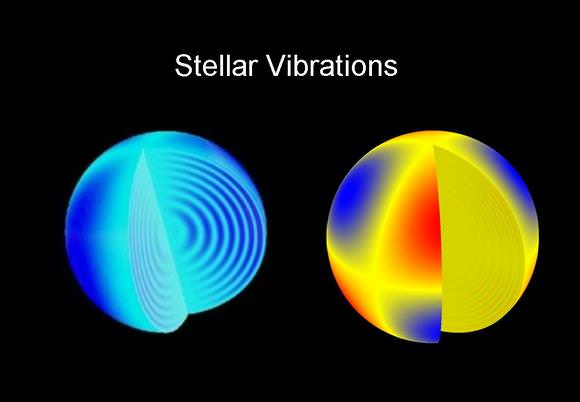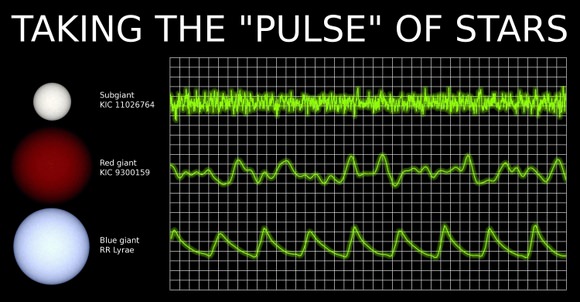[/caption]
Not only is the Kepler spacecraft hunting down extrasolar planets, but it also provides the ability to study stars in unprecedented detail. “We knew that if Kepler had the sensitivity of detecting Earth-size planets, that it would have capability to transform our knowledge of stars themselves,” said Natalie Batalha of San Jose State University in California, a co-investigator on the Kepler Astroseismic Science Consortium. This international partnership of over 400 astronomers uses the Kepler spacecraft to “listen” to tiny oscillations, or “star quakes,” in red giant stars, allowing scientists to do groundbreaking work in deducing the fundamental properties of stars.
In just the first year of Kepler’s operation, the team has been able to study thousands of stars using astroseismology, while previously only a few dozen of stars had been “listened to” using this technique.
“We can say Kepler is listening to thousands of musicians in the sky,” said Daniel Huber, a graduate student at the University of Sydney, during a webcast of a press conference about the new findings.
“From first year of the Kepler mission we moved from having a couple of dozen of stars with a couple of weeks of data,” said Travis Metcalfe, scientist at The National Center for Atmospheric Research, responding to a question posed by Universe today “to having one month to study each of a several thousands of stars. This is an enormous expansion of our capability to study this type of star and what the oscillations tells us.”
Similar to how seismologists study earthquakes to probe the Earth’s interior, astroseismology measures the natural pulse of light waves from stars to gain new insights into stellar structure and evolution.

“Kepler allows us to study the periods of stellar oscillations, and we use them to study the cores of stars — in a way to touch the stars — and get the most accurate measurements of stars we have ever made,” said Hans Kjeldsen, associate professor, KASC, Aarhus University in Denmark.
They can measure size and age with extreme precision and they have now characterized the structure and life cycle of over 1,000 red giants. What they have found so far confirms the current principals of stellar evolution and allows for better predictions of what might happen to our Sun in several billion years.
Kjeldsen said they are getting data of amazing quality. “We can now actually study stars of all phases and evolutionary stages, of different mass, and all different types. This is the amazing thing for me. Instead of looking one star for awhile and then moving on to next star, we now have access to thousands of stars at once. And having said that, there are still thousands and thousands of stars we still need to study.”
Metcalfe said astroseismology listens to the oscillations of the star, and can hear a tone so low that even a whale would have a hard time hearing it. Kepler can see even tiny oscillations as a flickering in the star.
“Sound waves travel into the star and bring information up to the surface, which Kepler can see as a tiny flickering in brightness of the star,” said astronomer Travis Metcalfe of The National Center for Atmospheric Research.
That flickering has a tone like the notes of a musical instrument. “We essentially measure the tone of these musical notes from the star,” he said. “Larger stars flicker in lower tones while smaller stars in higher tones.”
Listen to Daniel Huber's Red Giant Oscillation Symphony
One star that Metcalfe has been focusing on is a red giant, that measured twice the size of the Sun. KIC 11026764 now has the most accurately known properties of any star in the Kepler field. In fact, few stars in the universe are known to similar accuracy, the team said. The oscillations reveal that this star is 5.94 billion years old and is powered by hydrogen fusion in a thin shell around a helium-rich core.
In this consortium, no dollars are actually exchanged between nations. The US provides the Kepler instrument and software pipeline, while the international partners are supplying human resources of ingenuity and scientific expertise.
“We’re not just getting a great legacy of scientific results, but also a valuable symbiosis and partnership here,” said Batalha.
You can watch the press conference on Universe Today at this link.


Wow, I had no idea Kepler was being used for this. Asteroseismology allows you to confirm the temparature of the interior of stars and even the depths of various zones, density etc. In turn that can be used to measure their true luminosity, and measure their distances with greater accuracy plus a whole heap of other spinoffs,
Great collaboration and great science.
Once again, though, I wish people would think more carefully about communicating the results. The first graphic above, “Taking the ‘pulse’ of stars” is pretty but there is almost no way it can be used, as is, to excite, inspire, teach non-experts. There are no labels showing what is changing. No scale to indicate the size of the changes. And no credit for those whose curiosity is piqued to follow up on.
We “experts” have no trouble with the analogy to a heartbeat. Well, at least that the horizontal axis is time. But what is the vertical axis, anyway, in a heartbeat or this graph? Oh, maybe if I read the article I’ll find out. Sorry, that’s not good enough. This is just the kind of graphic that gets googled and dropped into PPT presentations. Without an expert at your side to interpret the graph, there’s little chance a reader or student could use this graph to learn any more about stars.
I’m not saying cover the graphic with ugly labels and tick marks and legends. There are elegant, subtle ways to provide the information, if a reader chooses to look more closely. Edward Tufte (www.edwardtufte.com) and @flowingdata are great places to start.
What I am saying is, let’s take a little more time to think about effectively communicating our astonishing and fascinating discoveries.
Peter
Just to beat IVAN3MAN to the punch, “principals” should be “principles” I think.
In the “stellar vibration” picture, the right graphic looks like a multipole expansion. I’m curious, since I just learned about them yesterday in my theoretical physics course. What is it used for in this case? It would be a very timely example for a mathematical tool that really piqued my interest!
And they wondered why Kepler and I were such instant love! 😀
@ Polaris.CA:
I’m not really speaking from a full layman representative (attending a university astrobiology class and all).
But laying skewed perspective and interests aside, I can “get” (or at least pose) that the graphic in question is fine and an excellent representative of “minimalism” in graphics.
[The sun IDs breaks that, to make ascertaining individual as opposed to average traces possible at a glance. I wouldn’t have included those, I think.]
People can at a glance recognize the analogy to EKG, so: check. I think they wouldn’t care less about the axes and what they stand for, so again: check.
As for the absence of credits (links, references) as opposed to the star names, I heartily agree. (But who knows what post-processing took place on UT?) And I have no doubt that there are better graph techniques out there, so thanks for _those_ links btw!
[I believe I remember the name Tufte. Alas, not being in the presentation business makes one forget what one never learned … or something like that.]
@ Matt S:
I’m not sure what you are asking for, but the one interpretation of “used for” I see is that the multipole expansion is likely over compressional wave intensity. I can see more intensely shaded layers in the star beneath the poles in the right figure.
(And then the left figure is likely a lower multipole mode of compressional waves too, see the color changes.)
In any case, Laplace equation and eigenfunctions FTW, huh!?
Thanks. Yeah! I was already surprised to learn that the fourier transformation and the eigenfunctions of the laplace operator had something to do with one another, to do the same in spherical coordinates was the icing on the cake! (: